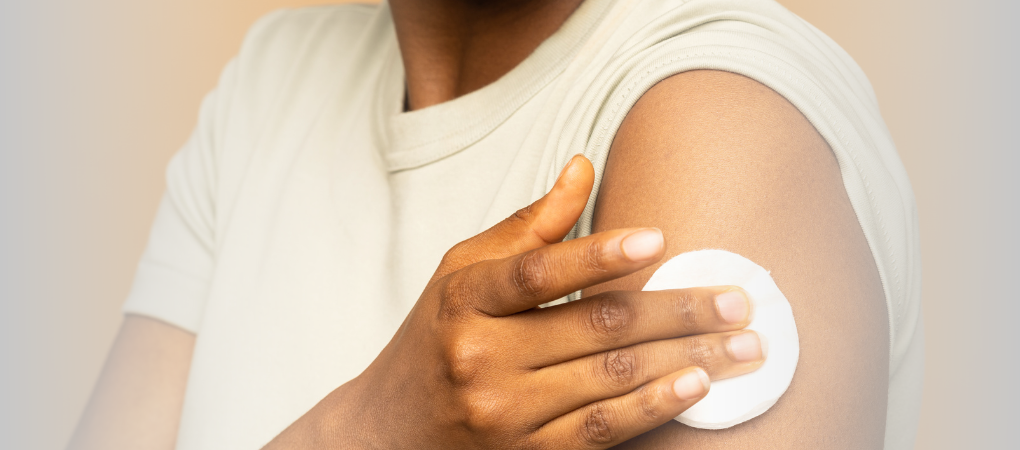Francesca Galiano
|
21/09/2022 - Last update 28/12/2022
Simrat Veera, Justin Chin, Lina Kleyn, Salvatore Spinelli, Leonid Tafler | Year 2020
Use of osteopathic manipulation for treatment of chronic shoulder injury related to vaccine administration
Pathology:
Shoulder injury related to vaccine administration
Type of study:
Case Report
Date of publication of the study’:
2020/Jun/12

Purpose of the study
- Objective: to report the utility of OMT in case of SIRVA, namely a complication defined by pain, reduced range of motion (ROM) and tissues inflammation that may culminate in bursitis, capsulitis or other manifestations, caused by an erroneous administration of the injection
- Measured outcomes: report of the symptomes
Participants
- Number: 1
- Description: 58-year-old woman, with a history of hypertension and right shoulder pain for 4 months, with related paresthesia of the hand and reduced ROM of the shoulder. These symptoms prevented her from carrying out daily activities and work (she was a nurse).
The symptoms started after the administration of an influenza vaccination, injected, according to its report, well below the deltoid (ideal point of administration). Previous hospital, medical, and orthopedic visits did not consider the condition to be a result of the injection, but assumed cervical problems and tendonitis in the right shoulder.
Since the injection of corticosteroids into the acromial bursa, the use of non-steroidal anti-inflammatory drugs and physiotherapy had minimal effects, the woman was advised to have surgery. Not convinced, she preferred to try an osteopathic assessment. The family and social history did not bear any relevant evidence. The cervical X rays were normal whereas the MRI of the shoulder, carried out 6 weeks after the vaccine, showed a mild rotator cuff tendinopathy with a partial tear, moderate bicipital tenosynovitis, and glenohumeral joint effusion.
The osteopathic evaluation showed essentially altered ROM of the shoulder, active and passive, especially in abduction and with tenderness at the point of injection. The Spurling compression test for cervical radiculopathy was negative.
Interventions and evaluations
- At the first visit, injection of methylprednisolone and lidocaine in the area of the vaccination to reduce inflammation
- At the follow-ups, methylprednisolone orally
- Weekly sessions of OMT (modified Spencer’s technique) for four months, against not improving symptoms
- During this time, the woman continued physiotherapy and started acupuncture treatments to the right shoulder
- 2 monthly sessions of OMT (modified Spencer’s technique with scapula lift) under general anesthesia with propofol
Results
Initially none of the therapies induced relevant effects. The first effects appeared after the first session of OMT carried out under general anesthesia: the ROM of the right shoulder, passive, active and pan-directional, did largely improve. The symptoms continued to resolve over the following month, during which the woman continued all the different therapies (acupuncture, OMT, not under anesthesia, and physiotherapy).
A new session of OMT under anesthesia practically restored the shoulder to a near-complete ROM, with a slight pain only after 130° of flexion/abduction Afterwards, she continued a few sessions of OMT and physiotherapy, but the symptoms had practically resolved.
Discussion
SIRVA is a particularly rare complication of vaccinal administration (only 112 cases between 2006 and 2016 in the United States) which mimics symptoms of several neurological pathologies. Although there are different recommendations aimed at avoiding SIRVA during the injection, the standard therapeutic effect (non steroidal anti inflammatories, corticosterone, physiotherapy and surgery) does not always seem to lead to success, as in the present case, in which the patient preferred to defer the invasive chirurgical intervention.
This study suggests how OMT performed under anesthesia may be an additional element to be included in the management of SIRVA, potentially when other therapies (non-steroidal anti-inflammatory, corticosterone, physiotherapy) have not been effective and before resorting to surgery. The anesthetic effect can promote muscle and fascial mobility, thus allowing the OMT to act on inflammatory states and tissue alteration (eg, fibrosis). Further studies are needed to understand how to best apply the connection of OMT to anesthesia, either general or local, as well as to understand the exact mechanism of effectiveness for which analgesic drugs can help OMT.
The review of Osteopedia
By Marco Chiera
Strengths: the study highlight the importance of evaluating a pathological condition under different point of views (inflammatory, neurological, biomechanical, etc.), thus shifting the focus on one “universal” mechanism (as often happens in manual therapies).
Limits: the use of the anesthesia prevents the evaluation of the effective effectiveness of OMT: potentially, also another treatment (eg, physiotherapy) applied under anesthesia could sort the same effect. Although few and non systematic, there are nevertheless different studies in the literature on manual therapies and analgesics that could have been cited and discussed. Likewise, the studies on the application of neural therapy could have been considered in the discussion, that is, as a matter of fact, the local injection of analgesics (or other substances) to alleviate and resolve neuromuscular and inflammatory conditions.

Are you an osteopath?
Register and enjoy the membership benefits. Create your public profile and publish your studies. It's free!
Register now
School or training institution?
Register and enjoy the membership benefits. Create your public profile and publish your studies. It's free!
Register now
Do you want to become an osteopath? Are you a student?
Register and enjoy the membership benefits. Create your public profile and publish your studies. It's free!
Register now







